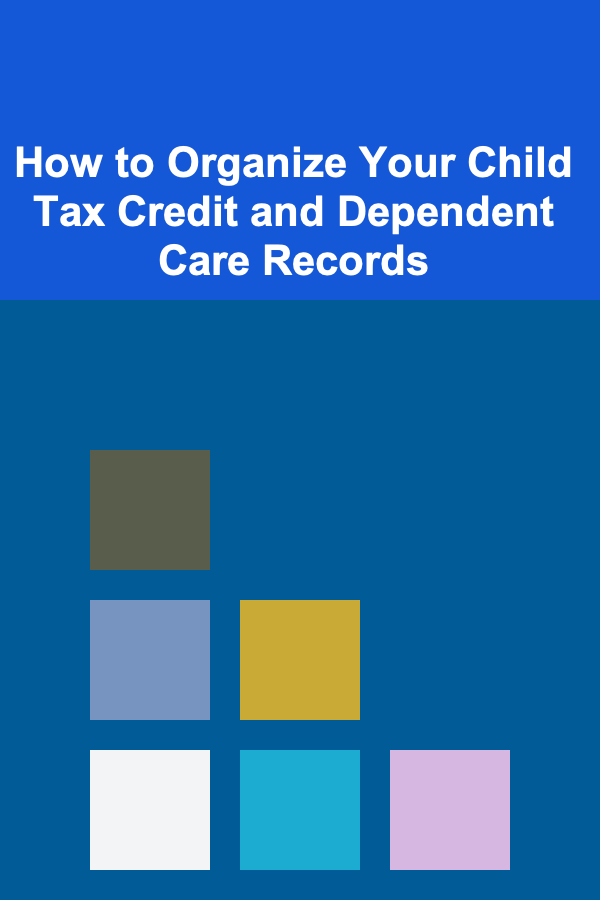
How to Organize Your Child Tax Credit and Dependent Care Records
ebook include PDF & Audio bundle (Micro Guide)
$12.99$7.99
Limited Time Offer! Order within the next:

Organizing your financial records, especially when it comes to tax-related documents, can be an overwhelming task, but it is essential for ensuring that you receive all the credits and deductions you are eligible for. Two key areas that parents and guardians should focus on are the Child Tax Credit (CTC) and Dependent Care Expenses. Properly managing and organizing these records can help you avoid mistakes, reduce stress during tax season, and ensure you maximize your tax benefits.
In this article, we will dive into how to organize your records for the Child Tax Credit and Dependent Care, what documents you need to keep, and how to keep them structured. Additionally, we will explore how a well-organized system can help you streamline your tax filing process and avoid complications.
Understand the Importance of the Child Tax Credit and Dependent Care Credit
Before jumping into the organizational aspects, let's briefly define the Child Tax Credit and the Dependent Care Credit and why they are important.
Child Tax Credit
The Child Tax Credit provides a financial benefit to parents and guardians of children under the age of 17. The amount of the credit depends on factors such as your income, the number of children you have, and your tax filing status. This credit can reduce the amount of taxes you owe or even result in a refund if the credit exceeds your tax liability.
Dependent Care Credit
The Dependent Care Credit is designed to help families offset the costs of daycare and other care services for dependents under the age of 13 or for individuals who are physically or mentally incapable of self-care. This credit can be significant for working parents who must pay for childcare services.
Both credits require specific documentation to claim them, and accurate record-keeping is crucial to ensure you are not missing out on any savings.
Determine the Required Documentation for Each Credit
To properly claim these credits, you will need to gather certain documents. This section will break down the required documentation for both the Child Tax Credit and Dependent Care Credit.
Documents for the Child Tax Credit
To claim the Child Tax Credit, the IRS requires proof of your child's identity and age, as well as information on your income and tax liability. Here are the essential documents you will need:
a. Proof of Child's Identity and Age
- Birth certificates: This is one of the most reliable ways to verify your child's age and relationship to you.
- Social Security cards: The IRS requires that each qualifying child have a valid Social Security number (SSN). If your child is eligible for the CTC, you'll need to provide their SSN.
b. Proof of Residency
- School records or health records: These documents help prove that the child lived with you for more than half of the year.
c. Income Information
- W-2 Forms: Your W-2s show the income you earned as an employee and are crucial for calculating the Child Tax Credit.
- 1040 Tax Form: This will show your income and help determine whether you're eligible for the full or partial credit.
d. Tax Filing Status
- Filing status: Your filing status (e.g., single, married, head of household) impacts your eligibility for the CTC. Ensure your filing status is accurately reflected in your tax records.
e. Other Relevant Documents
- Adoption records: If the child was adopted, providing official adoption documents may be necessary to establish the child's eligibility for the credit.
Documents for the Dependent Care Credit
To qualify for the Dependent Care Credit, you need to provide proof of the dependent care expenses you incurred, as well as the care provider's details. The following documents are essential:
a. Proof of Dependent Care Expenses
- Receipts from care providers: You must retain receipts that clearly show the amount paid for dependent care, the provider's name and address, and the dates of care.
- Bank statements or credit card statements: These can provide additional proof of payments made to care providers.
b. Provider's Information
- Care provider's Taxpayer Identification Number (TIN): This could be their Social Security number (SSN) or Employer Identification Number (EIN). The IRS requires this information when claiming the Dependent Care Credit.
c. Dependent Information
- Proof of dependent's age: Birth certificates or other official documents that verify the dependent is under the age of 13 or incapable of self-care.
d. Employment Information
- Proof of employment: Some people may need to show that they are working while incurring dependent care expenses. Keep your W-2s or other income documentation to verify that you meet this requirement.
Create a Filing System for Child Tax Credit and Dependent Care Records
Now that you understand which documents are necessary, it's time to focus on organizing them efficiently. An organized filing system will not only make tax season easier but also provide peace of mind knowing that you have all your important documents in one place.
a. Use a Digital Organization System
In today's digital world, using a digital filing system can be a great way to keep your records secure and easily accessible. There are several options for organizing your tax-related documents:
- Cloud storage: Services like Google Drive, Dropbox, or OneDrive allow you to upload and categorize your documents, ensuring you have access to them anywhere.
- Document management software: Software like Evernote or Microsoft OneNote can help you create digital notebooks where you can store scanned copies of all your important paperwork.
Key Tips for Digital Organization:
- Label files clearly with relevant details such as "Child Tax Credit 2025" or "Dependent Care Receipts 2025."
- Set up folders for each year, so you can easily differentiate your records from year to year.
- Regularly back up your files to avoid losing important information.
b. Create a Physical Filing System
For those who prefer a more traditional approach, organizing your records in physical files can be equally effective. Here's how to do it:
- Use folders: Purchase folders labeled for each credit and each year (e.g., "Child Tax Credit 2025," "Dependent Care Expenses 2025").
- Subfolders: Within each main folder, create subfolders for specific categories, such as "Child Birth Certificates," "Income Information," and "Care Provider Receipts."
- File your documents regularly: As you receive documents throughout the year, file them promptly to prevent them from piling up.
Key Tips for Physical Organization:
- Use color-coded folders or labels to easily distinguish between the Child Tax Credit and Dependent Care records.
- Keep important documents, such as birth certificates and Social Security cards, in a secure, fireproof box.
c. Use a Checklist
To ensure you don't miss anything, create a checklist for each credit that includes all the documents you need to gather. This can help you stay organized and ensure that you have everything in order before filing your taxes.
Checklist Example for Child Tax Credit:
- [ ] Birth certificate for each child
- [ ] Social Security numbers for all dependents
- [ ] W-2 and 1040 forms
- [ ] Proof of residency for each child (school records, health records)
- [ ] Adoption records (if applicable)
Checklist Example for Dependent Care Credit:
- [ ] Receipts from care providers
- [ ] Bank or credit card statements showing payments
- [ ] Care provider's Taxpayer Identification Number
- [ ] Proof of dependent's age (birth certificate)
- [ ] W-2s or other proof of employment
Review and Update Your Records Regularly
Financial records should be kept up-to-date, particularly when it comes to tax credits. Regularly review your documents to ensure everything is accurate and current.
- Review at least once a year: After tax season, set aside time to review your records, make any necessary updates, and prepare for the upcoming year.
- Store for the long term: Keep these records for several years, as the IRS may audit returns or ask for supporting documents within a three-year window.
How an Organized System Can Help You Save Time and Money
An organized record-keeping system is not only useful for tax filing but also helps you:
- Avoid penalties: Keeping accurate records ensures that you can back up your claims, reducing the risk of penalties or fines from the IRS.
- Simplify tax filing: By having all your documents neatly organized, you can easily calculate your credits and deductions, which makes tax filing faster and more accurate.
- Maximize your credits: Proper documentation ensures you can claim all available credits and deductions, leading to potential tax savings.
Conclusion
Organizing your Child Tax Credit and Dependent Care records is a critical step in ensuring you maximize your tax benefits and avoid unnecessary stress during tax season. By understanding the documentation required, setting up an organized system, and regularly reviewing your records, you can streamline your tax filing process and have confidence that you're not missing any savings.
Whether you prefer a digital or physical filing system, taking the time to stay organized will save you time and money in the long run, ensuring you can focus on what truly matters---caring for your family and planning for your financial future.
Reading More From Our Other Websites
- [Home Budget 101] How to Achieve Affordable Home Decor on a Tight Budget
- [Home Soundproofing 101] How to Use Green Soundproofing Solutions for Your Home
- [Gardening 101] 10 Essential Organic Gardening Hacks for a Thriving Garden
- [Home Rental Property 101] How to Prepare Your Rental Property for Inspections and Appraisals
- [Personal Financial Planning 101] How to Plan for Retirement: A Comprehensive Guide for Every Stage of Life
- [Organization Tip 101] How to Organize Pet Laundry Supplies
- [Star Gazing Tip 101] Celestial Storytelling: How Adults Can Use Star-Gazing to Relieve Stress and Spark Creativity
- [Home Rental Property 101] How to Search for Houses for Rent with a Pet‑Friendly Policy
- [Home Staging 101] How to Make Every Square Foot Count: Clever Home Staging for a Condo Balcony & Nook Areas
- [Organization Tip 101] How to Create a Master List of School Supplies for Each Grade

How to Cut Down on Subscriptions and Recurring Payments: An Actionable Guide
Read More
How to Use Slimline Furniture for Space-Saving in Small Homes
Read More
Make Money by Licensing Your Deep Learning Algorithms
Read More
How To Program Robots for Dynamic Environments
Read More
How To Learn About Diamond Vacancy Quantum Computers
Read More
10 Tips for a Yearly Financial Health Checkup
Read MoreOther Products

How to Cut Down on Subscriptions and Recurring Payments: An Actionable Guide
Read More
How to Use Slimline Furniture for Space-Saving in Small Homes
Read More
Make Money by Licensing Your Deep Learning Algorithms
Read More
How To Program Robots for Dynamic Environments
Read More
How To Learn About Diamond Vacancy Quantum Computers
Read More